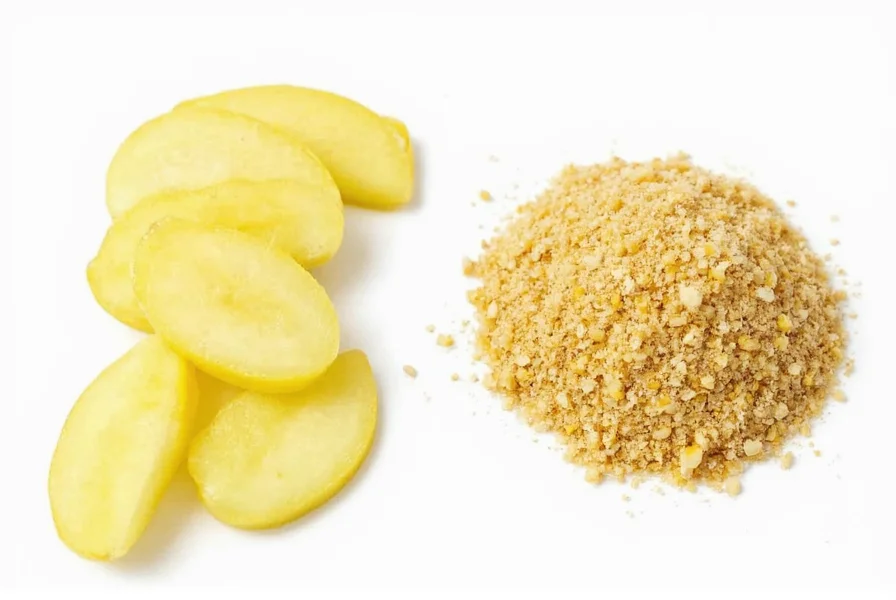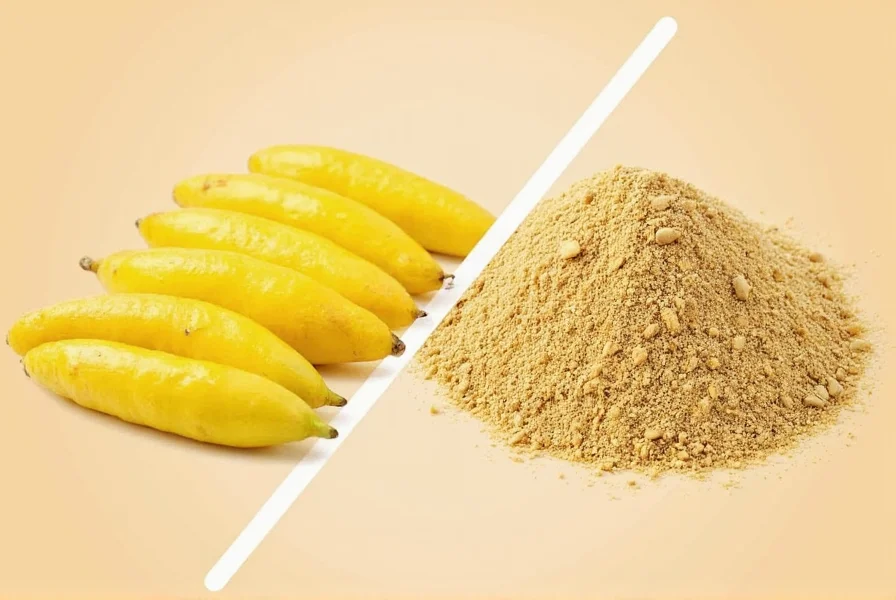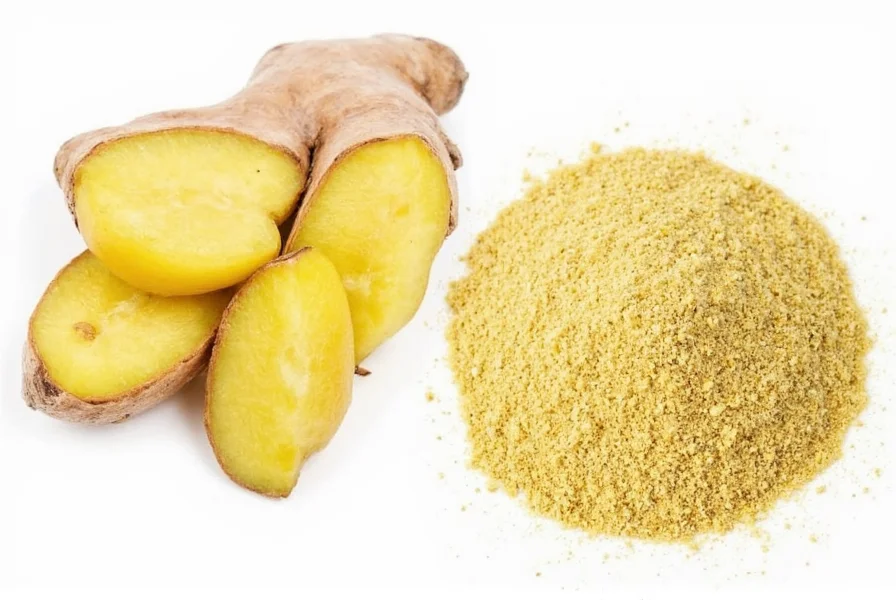Fresh ginger offers a bright, spicy, and complex flavor with citrusy notes, while ground ginger provides a warmer, more concentrated, and slightly sweeter taste. Fresh ginger contains higher levels of gingerol (the active compound), making it more potent for medicinal uses, whereas ground ginger has a longer shelf life but loses some volatile compounds during processing. For substitution, use 1/4 teaspoon of ground ginger for every tablespoon of fresh ginger called for in recipes.
Understanding the differences between fresh ginger versus ground ginger is essential for achieving the perfect flavor profile in your cooking. While both come from the same rhizome, their processing methods create distinct culinary characteristics that affect taste, potency, and application in recipes.
Flavor Profile Comparison
Fresh ginger delivers a vibrant, zesty punch with subtle citrus undertones and a noticeable heat that builds gradually. Its flavor is complex and multidimensional, with fresh, grassy notes that complement both sweet and savory dishes. Ground ginger, by contrast, has a warmer, more rounded flavor profile with less brightness but greater intensity in certain spice compounds. The drying process converts some gingerol to zingerone, creating a slightly sweeter, more mellow taste that works particularly well in baked goods.
Professional chefs often describe fresh ginger as having "more personality" in dishes where its texture and visual presence matter, while ground ginger provides consistent flavor distribution without fibrous bits. This distinction between fresh ginger and ground ginger becomes especially important when considering which form works best for specific culinary applications.
Physical Properties and Texture Differences
The physical differences between fresh ginger versus ground ginger significantly impact how they behave in cooking:
| Property | Fresh Ginger | Ground Ginger |
|---|---|---|
| Form | Rhizome with fibrous texture | Fine powder |
| Moisture Content | Approximately 80% | Nearly 0% |
| Active Compounds | Higher gingerol content | More zingerone and shogaols |
| Visual Impact | Visible pieces in dish | Uniform color distribution |
These physical differences explain why fresh ginger versus ground ginger can't always be substituted one-to-one in recipes without adjusting other elements. The moisture content alone affects baking chemistry, while the fibrous nature of fresh ginger creates textural elements that ground ginger cannot replicate.

Culinary Applications: When to Use Each Form
Understanding when to use fresh ginger instead of ground ginger can transform your cooking results. Fresh ginger shines in:
- Asian stir-fries and sauces where its bright flavor cuts through rich ingredients
- Marinades that benefit from its enzymatic tenderizing properties
- Teas and beverages where visual appeal matters
- Raw preparations like salads and ceviche
- Dishes where texture is part of the experience
Ground ginger works best for:
- Baking applications like gingerbread and spice cakes
- Dry rubs for meats where even spice distribution is crucial
- Commercial food production requiring consistent flavor
- Long-cooked dishes where fresh ginger might become fibrous
- Situations requiring precise spice measurement
Fresh Ginger to Ground Ginger Conversion Guide
One of the most common questions about fresh ginger versus ground ginger involves substitution ratios. The standard conversion is:
- 1 tablespoon freshly grated ginger = 1/4 teaspoon ground ginger
However, this simple ratio doesn't tell the whole story. When substituting ground ginger for fresh in recipes, consider these additional factors:
- Add the ground ginger earlier in the cooking process to allow flavors to develop
- Compensate for lost moisture by slightly adjusting liquid ingredients
- For medicinal applications, fresh ginger generally provides more potent therapeutic effects
- In baking, ground ginger creates a more uniform spice distribution
Professional bakers often recommend using 1/8 teaspoon of ground ginger for every tablespoon of fresh when making delicate pastries, while heartier dishes like curries might use the full 1/4 teaspoon ratio.
Nutritional and Medicinal Differences
While both forms offer health benefits, there are notable differences between fresh ginger and ground ginger nutritionally. Fresh ginger contains approximately 5% gingerol by weight, the compound responsible for many of ginger's health benefits, including anti-inflammatory and digestive properties. During the drying process that creates ground ginger, some gingerol converts to shogaols, which are more concentrated but less bioavailable.
Studies show that fresh ginger generally provides:
- Higher antioxidant activity
- Greater effectiveness for nausea relief
- More potent anti-inflammatory effects
- Better preservation of volatile oils
For those specifically using ginger for medicinal purposes, fresh ginger versus ground ginger represents a meaningful choice. Traditional medicine practitioners often recommend fresh ginger for acute conditions, while ground ginger serves better for daily supplementation due to its longer shelf life.

Storage Considerations and Shelf Life
Proper storage dramatically affects how long each form maintains its quality. Fresh ginger versus ground ginger has vastly different storage requirements:
- Fresh ginger: Store unpeeled in the refrigerator for 2-3 weeks, or freeze for up to 6 months. Peeled ginger should be stored in vodka or sherry in the refrigerator for extended freshness.
- Ground ginger: Keep in an airtight container away from light and heat. Properly stored, it maintains good flavor for 2-3 years, though peak potency lasts about 6-12 months.
Notice the aroma when opening your spice container - if ground ginger has little scent, it's lost most of its flavor compounds. Fresh ginger that becomes soft, moldy, or develops dark spots should be discarded.
Cost Analysis and Practical Recommendations
When comparing fresh ginger versus ground ginger from a cost perspective, fresh typically costs more per serving but offers superior flavor in many applications. A single ginger root (about 2 ounces) costs approximately $0.75-$1.50, yielding about 3 tablespoons of grated ginger. The equivalent amount in ground ginger (3/4 teaspoon) represents a fraction of a standard spice container that might cost $3-$5 but contains enough for dozens of recipes.
For home cooks, maintaining both forms in your pantry provides maximum flexibility. Keep a small piece of fresh ginger for immediate use in sauces and stir-fries, while relying on ground ginger for baking and long-term storage. When traveling or cooking away from home, ground ginger offers reliable flavor without refrigeration concerns.
Conclusion: Making the Right Choice for Your Recipe
The choice between fresh ginger versus ground ginger ultimately depends on your specific culinary goals. For vibrant, complex flavors in Asian cuisine or medicinal applications, fresh ginger delivers unmatched quality. When consistent spice distribution, long shelf life, or baking precision matters most, ground ginger proves invaluable. Understanding these differences between fresh and dried ginger empowers you to make informed decisions that elevate your cooking and maximize flavor potential in every dish.
Frequently Asked Questions
Can I substitute ground ginger for fresh ginger in recipes?
Yes, but with important considerations. The standard conversion is 1/4 teaspoon of ground ginger for every tablespoon of fresh ginger. However, this simple ratio doesn't account for moisture differences or flavor profile changes. For best results in savory dishes, use slightly less ground ginger (1/8 teaspoon per tablespoon of fresh) and add it earlier in the cooking process. Baking recipes typically handle the substitution better than fresh applications like salads or teas.
Which has more health benefits: fresh ginger or ground ginger?
Fresh ginger generally contains higher levels of gingerol, the primary active compound responsible for ginger's anti-inflammatory and digestive benefits. Studies show fresh ginger has approximately 30-50% more available gingerol than ground ginger. However, ground ginger contains higher concentrations of shogaols, which form during the drying process and have their own health benefits. For maximum medicinal effect, fresh ginger is preferred, but ground ginger still offers significant health advantages with greater convenience and shelf stability.
Why does my recipe specify fresh ginger instead of ground?
Recipes specify fresh ginger when the chef wants the bright, complex flavor and textural element that only fresh ginger provides. Fresh ginger contains volatile oils that evaporate during the drying process, creating a more vibrant taste profile. It also adds visual appeal with its distinctive fibers and works better in raw applications. Many Asian recipes call for fresh ginger specifically because its enzymatic properties help tenderize proteins and its moisture content affects sauce consistency in ways ground ginger cannot replicate.
How do I store fresh ginger to maximize its shelf life?
Store unpeeled fresh ginger in the refrigerator's vegetable drawer for 2-3 weeks. For longer storage, place it in a sealed container with enough water to cover, changing the water every few days, which can extend freshness to 4-6 weeks. Alternatively, freeze whole or sliced ginger in a freezer bag for up to 6 months - frozen ginger grates easily without thawing. Peeled ginger should be stored submerged in sherry or vodka in the refrigerator, which preserves it for several months while adding flavor complexity.











 浙公网安备
33010002000092号
浙公网安备
33010002000092号 浙B2-20120091-4
浙B2-20120091-4